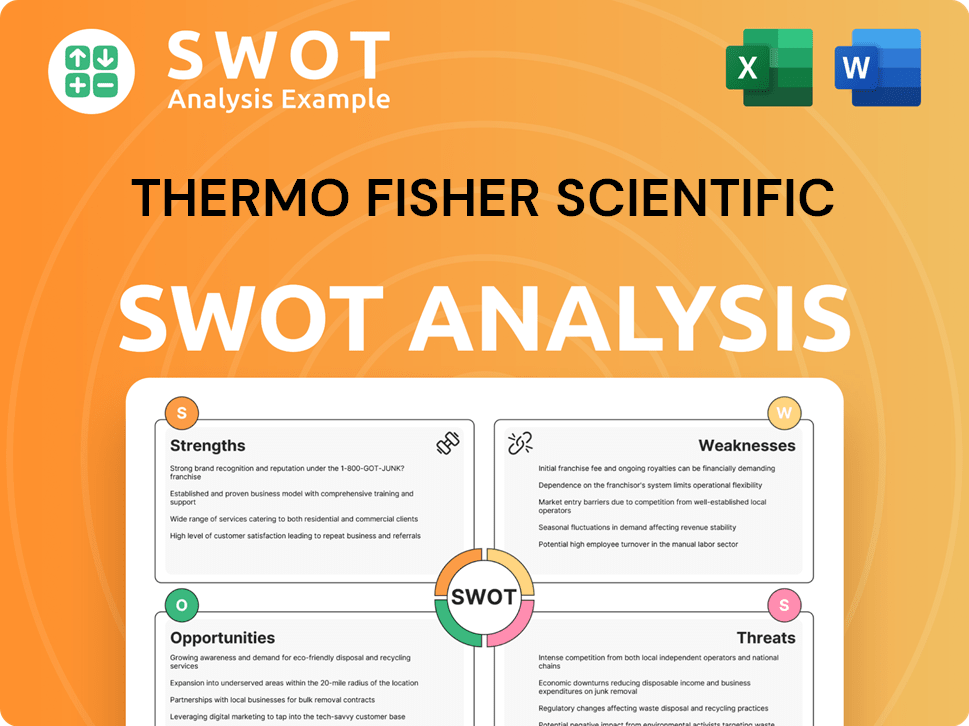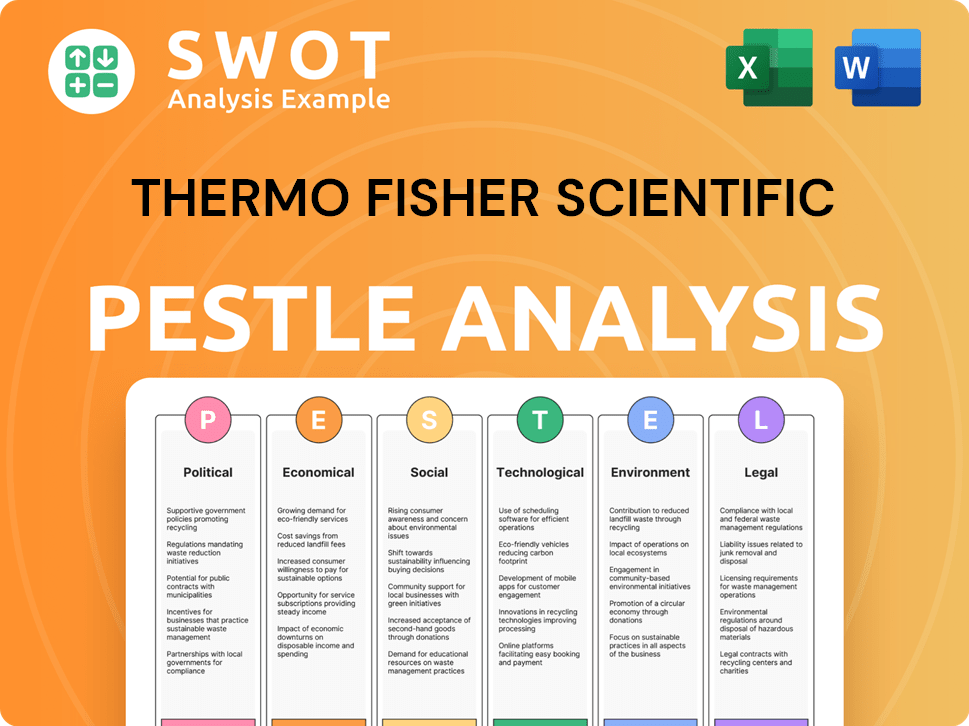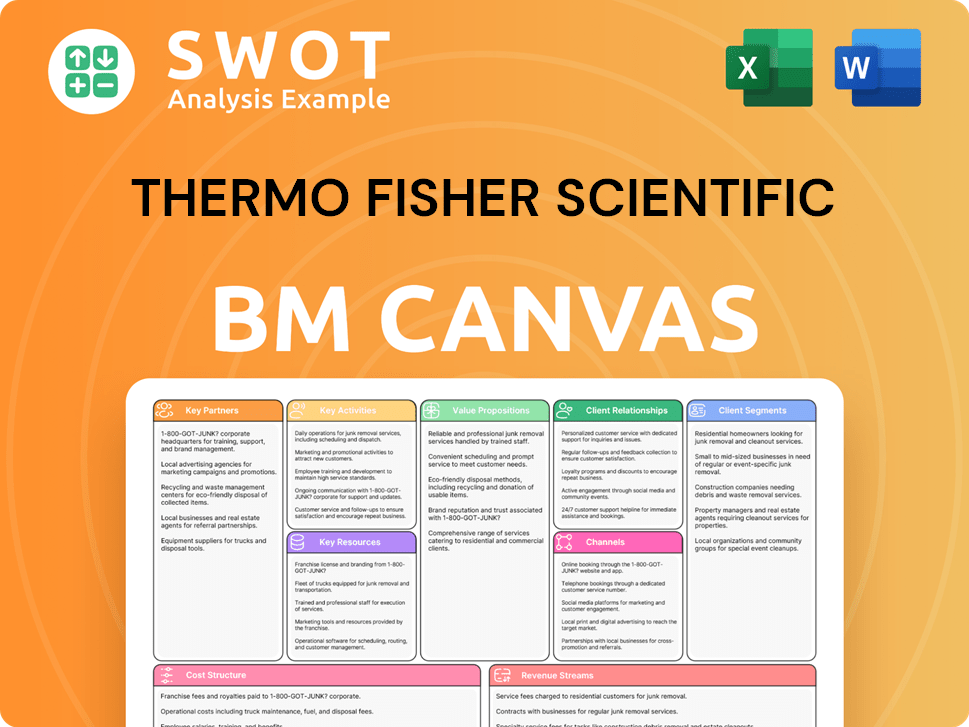Thermo Fisher Scientific Bundle
How Does Thermo Fisher Scientific Dominate the Life Sciences Arena?
Thermo Fisher Scientific, a pivotal player in the burgeoning life sciences industry, is experiencing remarkable growth, fueled by advances in biotechnology and diagnostics. Its influence spans from accelerating research to improving patient care, making it a critical force in global scientific progress. But how does this scientific powerhouse maintain its edge in a competitive market?

Founded in 1956, Thermo Fisher Scientific has evolved into a global leader, significantly expanding its reach through strategic mergers and acquisitions. Thermo Fisher Scientific SWOT Analysis reveals the company's strengths and weaknesses within the competitive landscape. By examining its market share, key competitors, and industry trends, we uncover the core differentiators that sustain its leadership. This in-depth company analysis will explore Thermo Fisher Scientific's competitive advantages and its strategic positioning in the face of its rivals.
Where Does Thermo Fisher Scientific’ Stand in the Current Market?
Thermo Fisher Scientific holds a strong market position within the life sciences and analytical instruments sector. Its comprehensive portfolio and global reach contribute significantly to its leadership. The company is a key player across various segments, including analytical instruments, lab equipment, reagents, consumables, and services.
The company's diverse customer base, including pharmaceutical and biotechnology companies, academic institutions, government agencies, and industrial and clinical laboratories, allows for resilience against market fluctuations. Its strategic shift towards integrated solutions, offering end-to-end workflows and digital solutions, further strengthens its market position. Growth Strategy of Thermo Fisher Scientific highlights the company's expansion plans.
Financially, the company consistently demonstrates strong performance, often surpassing industry averages in revenue growth and profitability. For the fiscal year 2024, analysts projected continued robust financial health, underscoring its scale and stability compared to many industry peers. Emerging markets, particularly in Asia, represent significant investment and growth areas.
Thermo Fisher Scientific consistently ranks among the top providers in its key areas, often holding the largest or second-largest market share. Its leadership is particularly evident in mass spectrometry, chromatography, and electron microscopy. The company’s strong market position is a result of its broad product offerings and global presence.
With operations in over 100 countries, Thermo Fisher Scientific serves a diverse customer base. This includes pharmaceutical and biotechnology companies, academic and research institutions, government agencies, and industrial and clinical laboratories. This broad customer base helps to mitigate risks and supports sustained growth.
Thermo Fisher Scientific consistently reports strong financial results, with revenue growth often exceeding industry averages. This robust performance is a key indicator of its competitive advantage. The company's focus on innovation and strategic acquisitions has contributed to its financial success.
The company is shifting towards becoming a more integrated solutions provider, offering end-to-end workflows and digital solutions. This strategic move enhances laboratory productivity and data management. This focus on digital transformation is a key element of its growth strategy.
Thermo Fisher Scientific's strengths include its broad product portfolio, global reach, and strong financial performance. Its competitive advantages come from its integrated solutions approach and focus on digital transformation. These factors enable the company to maintain its market position and drive future growth.
- Extensive Product Portfolio: Offering a wide range of scientific instruments, equipment, and services.
- Global Presence: Serving customers in over 100 countries, providing a significant competitive advantage.
- Financial Stability: Consistently strong financial performance, supporting investments in R&D and acquisitions.
- Integrated Solutions: Providing end-to-end workflows and digital solutions to enhance customer value.
Thermo Fisher Scientific SWOT Analysis
- Complete SWOT Breakdown
- Fully Customizable
- Editable in Excel & Word
- Professional Formatting
- Investor-Ready Format

Who Are the Main Competitors Challenging Thermo Fisher Scientific?
The Competitive Landscape for Thermo Fisher Scientific is dynamic, with both direct and indirect competitors vying for market share across its diverse business segments. Understanding this landscape is crucial for assessing Thermo Fisher Scientific's market position and its ability to sustain growth. The company faces competition in various areas, including life sciences solutions, analytical instruments, specialty diagnostics, and laboratory products and services. This analysis helps in understanding Thermo Fisher Scientific's strengths and weaknesses relative to its rivals.
Thermo Fisher Scientific operates in a highly competitive environment, which demands continuous innovation and strategic adaptation. The company's success depends on its ability to differentiate its products and services, maintain a strong brand reputation, and effectively navigate industry trends. This company analysis provides insights into the key players and their strategies, offering a comprehensive view of the competitive dynamics.
The competitive intensity is fueled by the need to address evolving customer demands and technological advancements. Thermo Fisher Scientific must continually invest in research and development to stay ahead of the curve. This includes identifying and capitalizing on emerging opportunities, such as personalized medicine and advanced analytical techniques. For more insights, read about the Target Market of Thermo Fisher Scientific.
Thermo Fisher Scientific's direct competitors include companies that offer similar products and services across its core business segments. These rivals often compete head-to-head in the same markets, vying for the same customers and projects.
Danaher is a major competitor, particularly in the life sciences and diagnostics sectors. It has a diversified portfolio that overlaps significantly with Thermo Fisher Scientific's offerings. Danaher's strong presence in biotechnology tools and analytical instruments makes it a formidable rival.
Agilent Technologies is another key competitor, especially in analytical instrumentation. It competes directly with Thermo Fisher Scientific in chromatography, mass spectrometry, and related areas. Agilent's focus on specialized analytical workflows places it in direct competition for high-value research and quality control applications.
BD competes primarily in the diagnostics and medical device space. It offers a broad range of products for specimen collection, disease diagnosis, and drug delivery. This overlaps with Thermo Fisher Scientific's clinical diagnostics offerings, making BD a significant competitor in this segment.
Indirect competition comes from specialized companies and academic institutions. These entities may focus on niche areas or develop proprietary technologies that challenge Thermo Fisher Scientific's broad market presence. Startups and emerging technologies also contribute to the indirect competitive landscape.
Illumina is a key player in sequencing technologies, a critical area for life science research. While not a direct competitor across all segments, Illumina's strong presence in genomics makes it a significant indirect competitor, especially in areas where Thermo Fisher Scientific has a strong presence.
The competitive landscape is continually reshaped by mergers, acquisitions, and strategic alliances. These actions force all players to adapt their strategies to maintain or improve their market positions. Thermo Fisher Scientific's ability to respond to these changes is crucial for its future success.
- Market Share: Analyzing market share is essential for understanding the competitive landscape. Data from 2024 indicates that Thermo Fisher Scientific holds a significant portion of the market in several key segments, but faces strong competition from Danaher, Agilent, and BD.
- Industry Trends: Industry trends, such as the growth of personalized medicine and the increasing demand for advanced analytical techniques, influence the competitive dynamics. Companies that can adapt to these trends are more likely to succeed.
- Recent Acquisitions: Thermo Fisher Scientific's recent acquisitions, like the purchase of PPD in 2021, have significantly expanded its capabilities and market reach. These acquisitions impact the competitive landscape by consolidating market share and broadening product offerings.
- R&D Spending: Thermo Fisher Scientific's research and development spending is a key factor in maintaining its competitive edge. The company invests heavily in R&D to drive innovation and develop new products. In 2024, Thermo Fisher Scientific allocated a substantial portion of its revenue to R&D, aiming to stay ahead of competitors.
- Competitive Advantages: Thermo Fisher Scientific's competitive advantages include its broad product portfolio, strong brand reputation, and global presence. Its ability to offer comprehensive solutions across various scientific disciplines provides a significant advantage.
Thermo Fisher Scientific PESTLE Analysis
- Covers All 6 PESTLE Categories
- No Research Needed – Save Hours of Work
- Built by Experts, Trusted by Consultants
- Instant Download, Ready to Use
- 100% Editable, Fully Customizable

What Gives Thermo Fisher Scientific a Competitive Edge Over Its Rivals?
Understanding the competitive landscape of Thermo Fisher Scientific involves recognizing its core strengths and how they contribute to its market position. The company's success is built on a foundation of proprietary technologies, a strong brand, and an extensive global reach. This analysis will delve into the key competitive advantages that have allowed Thermo Fisher Scientific to maintain its leadership in the scientific research and healthcare industries, offering insights into its strategic moves and market dynamics.
Thermo Fisher Scientific's competitive advantages stem from its innovation, customer loyalty, and operational efficiency. Its integrated offerings, including instruments, consumables, software, and services, create a sticky ecosystem for customers. The company’s consistent investment in research and development, with projections for continued high levels in 2024, ensures a steady stream of innovative products, reinforcing its technological leadership.
Thermo Fisher Scientific's technological edge is evident in its advanced instruments and proprietary technologies. For example, its Orbitrap mass spectrometry platforms provide superior analytical performance. This technological leadership is consistently reinforced through substantial annual investments in research and development.
The company benefits from strong brand recognition and customer loyalty, built over decades of reliable performance. Brands like Applied Biosystems and Invitrogen are highly trusted within the scientific community. This translates into strong customer retention and a willingness to adopt new products.
Thermo Fisher Scientific leverages its scale to achieve significant economies in manufacturing, procurement, and distribution. Its global distribution network efficiently reaches customers worldwide. This robust supply chain ensures product availability and reduces lead times, a critical factor for laboratories.
The 'razor and blade' model, where the initial instrument purchase leads to recurring revenue from consumables and service contracts, strengthens customer loyalty. This integrated approach provides a stable revenue stream. The company also benefits from its vast talent pool of skilled scientists and engineers, fostering innovation.
Thermo Fisher Scientific's competitive advantages are multi-faceted, including technological leadership, brand strength, and operational efficiency. The company's focus on integrated solutions and digital connectivity further enhances its market position. To learn more about the company's structure, consider reading about Owners & Shareholders of Thermo Fisher Scientific.
- Proprietary Technologies: Advanced instruments and numerous patents provide a significant barrier to entry.
- Brand Recognition: Strong brands and decades of reliable performance foster customer loyalty.
- Economies of Scale: Extensive global reach and efficient operations reduce costs and improve service.
- Integrated Solutions: The 'razor and blade' model ensures recurring revenue and strengthens customer relationships.
Thermo Fisher Scientific Business Model Canvas
- Complete 9-Block Business Model Canvas
- Effortlessly Communicate Your Business Strategy
- Investor-Ready BMC Format
- 100% Editable and Customizable
- Clear and Structured Layout

What Industry Trends Are Reshaping Thermo Fisher Scientific’s Competitive Landscape?
Understanding the Brief History of Thermo Fisher Scientific is crucial for analyzing its current standing within the competitive landscape. The company faces a dynamic environment shaped by continuous technological advancements, evolving regulatory landscapes, and global economic shifts. These factors present both challenges and opportunities that will influence its future outlook.
The life sciences industry is experiencing significant transformations, including the rise of AI, personalized medicine, and decentralized testing. These trends impact Thermo Fisher Scientific's market position, requiring strategic adaptation to maintain and enhance its competitive advantages. Analyzing its strengths and weaknesses in relation to these trends is essential for a comprehensive company analysis.
Technological advancements in areas like genomics and AI are accelerating research and discovery. The increasing adoption of AI and machine learning is a significant trend, offering opportunities for Thermo Fisher Scientific to enhance its software offerings and integrate AI into its instruments. The market for AI in drug discovery is projected to reach over $4.8 billion by 2027.
Regulatory changes, particularly in diagnostics and clinical research, are becoming more stringent, requiring companies to navigate complex compliance landscapes. Global economic shifts, including inflation and supply chain disruptions, pose ongoing challenges, potentially impacting manufacturing costs and product availability. Intensified competition from Asian manufacturers offering lower-cost alternatives could also challenge established players.
The increased demand for personalized medicine and precision diagnostics is a major opportunity, driving the need for advanced analytical tools and consumables. Emerging markets, particularly in Asia-Pacific, offer significant growth potential as healthcare infrastructure and life science research expand. Product innovations in areas like cell and gene therapy manufacturing, as well as strategic partnerships will be crucial for future growth.
Thermo Fisher Scientific is focusing on expanding its service offerings, investing in digital solutions, and pursuing targeted acquisitions to strengthen its portfolio and market reach. The company is actively working to remain resilient in a dynamic industry. These strategies aim to evolve its competitive position and maintain leadership.
To maintain its competitive edge, Thermo Fisher Scientific must focus on several key areas. These include strategic investments in R&D, particularly in AI and data analytics, to enhance its product offerings. Expanding its presence in emerging markets, especially in the Asia-Pacific region, will be crucial for future growth. The company should also actively pursue strategic partnerships and acquisitions to strengthen its portfolio and market reach.
- Innovation: Continuous development of new products and technologies.
- Market Expansion: Targeting high-growth regions and markets.
- Strategic Partnerships: Collaborating with other companies and institutions.
- Operational Efficiency: Streamlining processes to reduce costs.
Thermo Fisher Scientific Porter's Five Forces Analysis
- Covers All 5 Competitive Forces in Detail
- Structured for Consultants, Students, and Founders
- 100% Editable in Microsoft Word & Excel
- Instant Digital Download – Use Immediately
- Compatible with Mac & PC – Fully Unlocked

Related Blogs
- What are Mission Vision & Core Values of Thermo Fisher Scientific Company?
- What is Growth Strategy and Future Prospects of Thermo Fisher Scientific Company?
- How Does Thermo Fisher Scientific Company Work?
- What is Sales and Marketing Strategy of Thermo Fisher Scientific Company?
- What is Brief History of Thermo Fisher Scientific Company?
- Who Owns Thermo Fisher Scientific Company?
- What is Customer Demographics and Target Market of Thermo Fisher Scientific Company?
Disclaimer
All information, articles, and product details provided on this website are for general informational and educational purposes only. We do not claim any ownership over, nor do we intend to infringe upon, any trademarks, copyrights, logos, brand names, or other intellectual property mentioned or depicted on this site. Such intellectual property remains the property of its respective owners, and any references here are made solely for identification or informational purposes, without implying any affiliation, endorsement, or partnership.
We make no representations or warranties, express or implied, regarding the accuracy, completeness, or suitability of any content or products presented. Nothing on this website should be construed as legal, tax, investment, financial, medical, or other professional advice. In addition, no part of this site—including articles or product references—constitutes a solicitation, recommendation, endorsement, advertisement, or offer to buy or sell any securities, franchises, or other financial instruments, particularly in jurisdictions where such activity would be unlawful.
All content is of a general nature and may not address the specific circumstances of any individual or entity. It is not a substitute for professional advice or services. Any actions you take based on the information provided here are strictly at your own risk. You accept full responsibility for any decisions or outcomes arising from your use of this website and agree to release us from any liability in connection with your use of, or reliance upon, the content or products found herein.